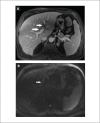Biliary Tract Injury in Patients With COVID-19: A Review of the Current Literature
- PMID: 36397771
- PMCID: PMC9666809
Biliary Tract Injury in Patients With COVID-19: A Review of the Current Literature
Abstract
Multiple studies and extensive clinical experience have shown that COVID-19 can impact the hepatobiliary system, with most reports describing primarily hepatocellular injury with elevations of aspartate aminotransferase and alanine aminotransferase. In addition to hepatocellular injury, recent literature has described a pattern of severe biliary tract injury resulting in patients with COVID-19. This novel syndrome, termed COVID-19 cholangiopathy, may have severe consequences for affected patients. This article will examine the literature describing this novel entity, its relationship to secondary sclerosing cholangitis, clinical outcomes, and proposed mechanisms underlying this form of biliary injury.
Keywords: COVID-19; bile duct injury; cholangiopathy; liver; sclerosing cholangitis.
Copyright © 2022, Gastro-Hep Communications, Inc.
Figures



Similar articles
-
COVID-19 related biliary injury: A review of recent literature.World J Gastroenterol. 2023 Apr 14;29(14):2127-2133. doi: 10.3748/wjg.v29.i14.2127. World J Gastroenterol. 2023. PMID: 37122603 Free PMC article. Review.
-
Secondary Sclerosing Cholangitis After SARS-CoV2: ICU Ketamine Use or Virus-Specific Biliary Tropism and Injury in the Context of Biliary Ischemia in Critically Ill Patients?Hepat Med. 2023 Aug 1;15:93-112. doi: 10.2147/HMER.S384220. eCollection 2023. Hepat Med. 2023. PMID: 37547355 Free PMC article.
-
Post-COVID-19 Secondary Sclerosing Cholangitis: A Rare but Severe Condition with no Treatment Besides Liver Transplantation.Am J Case Rep. 2022 Aug 18;23:e936250. doi: 10.12659/AJCR.936250. Am J Case Rep. 2022. PMID: 35978523 Free PMC article.
-
Ischemic-like cholangiopathy with secondary sclerosing cholangitis in critically ill patients.Am J Gastroenterol. 2007 Jun;102(6):1221-9. doi: 10.1111/j.1572-0241.2007.01118.x. Am J Gastroenterol. 2007. PMID: 17531010
-
Secondary sclerosing cholangitis.Nat Rev Gastroenterol Hepatol. 2009 May;6(5):287-95. doi: 10.1038/nrgastro.2009.46. Nat Rev Gastroenterol Hepatol. 2009. PMID: 19404269 Review.
Cited by
-
Post-COVID-19 Cholangiopathy: Clinical and Radiologic Findings.Korean J Radiol. 2023 Nov;24(11):1167-1171. doi: 10.3348/kjr.2023.0832. Korean J Radiol. 2023. PMID: 37899526 Free PMC article. No abstract available.
-
Post-COVID-19 cholangiopathy: Current understanding and management options.World J Gastrointest Surg. 2023 May 27;15(5):788-798. doi: 10.4240/wjgs.v15.i5.788. World J Gastrointest Surg. 2023. PMID: 37342848 Free PMC article. Review.
References
-
- Budden KF, Gellatly SL, Wood DLA et al. Emerging pathogenic links between microbiota and the gut-lung axis. Nat Rev Microbiol. 2017;15(1):55–63. - PubMed
-
- Margulis SJ, Honig CL, Soave R, Govoni AF, Mouradian JA, Jacobson IM. Biliary tract obstruction in the acquired immunodeficiency syndrome. Ann Intern Med. 1986;105(2):207–210. - PubMed
LinkOut - more resources
Full Text Sources
